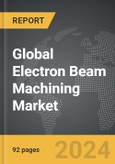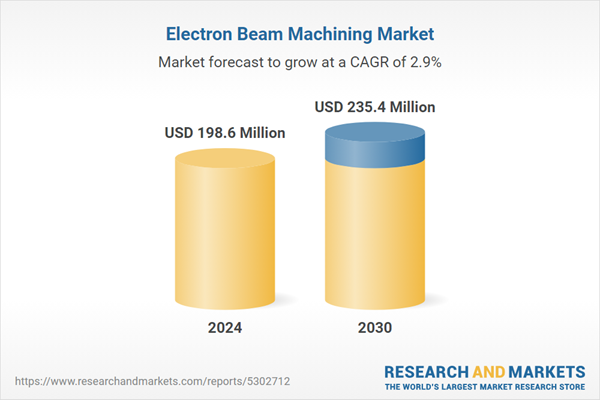Global Electron Beam Machining (EBM) Market - Key Trends & Drivers Summarized
What Is Electron Beam Machining (EBM) and Why Is It Critical for High-Precision Manufacturing?
Electron Beam Machining (EBM) is an advanced machining process that uses high-velocity electron beams to remove material with extreme precision, achieving ultra-fine detailing and finishing. EBM is particularly valuable in industries where high-precision, high-tolerance components are essential, such as aerospace, automotive, medical devices, and microelectronics. The EBM process focuses a concentrated beam of electrons onto the material, which generates localized heat, instantly vaporizing or melting it. This non-contact machining method minimizes mechanical stress on the workpiece and is ideal for creating intricate designs in hard-to-machine materials like titanium, tungsten, and high-performance alloys.EBM's unique ability to achieve high precision and produce micro-features without tool wear or distortion makes it indispensable for applications requiring complex geometries and exacting standards. In the aerospace industry, for example, EBM is used to manufacture turbine blades, nozzles, and other components that must withstand extreme operating conditions. In the medical sector, EBM is used to fabricate high-precision surgical instruments and implants. The push for lightweight, durable, and miniaturized components across industries is amplifying the demand for EBM, positioning it as a critical technology in high-precision manufacturing.
How Are Technological Advancements Driving Innovation in Electron Beam Machining?
Technological advancements are pushing the boundaries of Electron Beam Machining, enhancing its precision, efficiency, and applicability across various materials. Improvements in electron beam control systems have allowed for better precision and faster machining speeds, enabling manufacturers to create finer details and reduce cycle times. Innovations in beam modulation, such as pulsed EBM, allow operators to control the electron beam's intensity and duration, which is crucial when working with delicate or temperature-sensitive materials. These advancements enhance EBM's ability to machine ultra-thin sections without damaging the structural integrity of the material.Additionally, automation and CNC integration in EBM systems have made the process more accessible and adaptable to industrial manufacturing environments. Automated EBM systems can run continuously and produce complex parts with minimal operator intervention, which is essential for large-scale manufacturing in sectors like automotive and medical devices. Developments in vacuum technology have also improved EBM efficiency, as maintaining a stable, ultra-clean vacuum environment allows for optimal electron beam focus and reduces the risk of contamination. Together, these technological advancements are expanding EBM's application range and making it more efficient, reliable, and scalable for high-precision manufacturing.
What Are the Key Applications of Electron Beam Machining?
Electron Beam Machining has wide-ranging applications across industries that require high-precision components and specialized material handling. In the aerospace industry, EBM is used extensively to create turbine blades, cooling holes, and other critical parts that need high dimensional accuracy and surface integrity. EBM's ability to work with high-temperature-resistant alloys, like Inconel and titanium, makes it ideal for components that operate in extreme conditions. The automotive sector also benefits from EBM in the production of fuel injectors, nozzles, and small engine components, where high precision and durability are essential for fuel efficiency and performance.In the medical industry, EBM is instrumental in manufacturing implants, surgical instruments, and microtools that require exact specifications and biocompatibility. EBM's precision enables manufacturers to create smooth surfaces on medical implants, reducing post-processing needs and improving patient outcomes. Additionally, the microelectronics and semiconductor industries use EBM to fabricate intricate components, such as micro-circuits and sensors, where tight tolerances and minimal thermal distortion are essential. These applications showcase the versatility of EBM in producing high-quality components across sectors that prioritize precision, durability, and efficiency.
What Is Driving Growth in the Electron Beam Machining Market?
The growth in the Electron Beam Machining market is driven by several key factors, including rising demand for high-precision manufacturing, advancements in EBM technology, and the expanding adoption of hard-to-machine materials across industries. The aerospace and defense industries are major growth drivers, as they require components with exacting tolerances and exceptional durability. The push for lightweight and high-strength materials in aerospace and automotive applications has increased the demand for EBM, as it allows for precise machining of complex shapes in materials like titanium and superalloys. The growing reliance on renewable energy and the rise of electric vehicles are also spurring demand for high-performance, lightweight components, further boosting the EBM market.Advancements in EBM technology, including enhanced beam control, automation, and improved vacuum systems, are making EBM more accessible and cost-effective for large-scale manufacturing, driving its adoption in sectors such as medical devices and microelectronics. The medical sector's growing demand for precise, biocompatible implants and instruments is also a significant growth driver, as EBM allows for detailed, customized designs that improve patient outcomes. Additionally, the miniaturization trend in electronics has expanded EBM's role in producing micro-components that require high precision and minimal thermal distortion.
Together, these factors - demand for high-precision components, technology advancements, the use of specialized materials, and evolving industry needs - are driving robust growth in the EBM market. As industries continue to prioritize precision, durability, and material efficiency, EBM is set to remain a foundational technology in high-performance manufacturing.
Report Scope
The report analyzes the Electron Beam Machining market, presented in terms of market value (US$ Thousand). The analysis covers the key segments and geographic regions outlined below.- Segments: Application (Welding, Surface Treatment, Drilling); End-Use (Automotive, Aerospace & Defense, Other End-Uses).
- Geographic Regions/Countries:World; United States; Canada; Japan; China; Europe (France; Germany; Italy; United Kingdom; Spain; Russia; and Rest of Europe); Asia-Pacific (Australia; India; South Korea; and Rest of Asia-Pacific); Latin America (Argentina; Brazil; Mexico; and Rest of Latin America); Middle East (Iran; Israel; Saudi Arabia; United Arab Emirates; and Rest of Middle East); and Africa.
Key Insights:
- Market Growth: Understand the significant growth trajectory of the Welding Application segment, which is expected to reach US$100.8 Million by 2030 with a CAGR of a 3.3%. The Surface Treatment Application segment is also set to grow at 2.7% CAGR over the analysis period.
- Regional Analysis: Gain insights into the U.S. market, valued at $53.5 Million in 2024, and China, forecasted to grow at an impressive 4.9% CAGR to reach $46.3 Million by 2030. Discover growth trends in other key regions, including Japan, Canada, Germany, and the Asia-Pacific.
Why You Should Buy This Report:
- Detailed Market Analysis: Access a thorough analysis of the Global Electron Beam Machining Market, covering all major geographic regions and market segments.
- Competitive Insights: Get an overview of the competitive landscape, including the market presence of major players across different geographies.
- Future Trends and Drivers: Understand the key trends and drivers shaping the future of the Global Electron Beam Machining Market.
- Actionable Insights: Benefit from actionable insights that can help you identify new revenue opportunities and make strategic business decisions.
Key Questions Answered:
- How is the Global Electron Beam Machining Market expected to evolve by 2030?
- What are the main drivers and restraints affecting the market?
- Which market segments will grow the most over the forecast period?
- How will market shares for different regions and segments change by 2030?
- Who are the leading players in the market, and what are their prospects?
Report Features:
- Comprehensive Market Data: Independent analysis of annual sales and market forecasts in US$ Million from 2024 to 2030.
- In-Depth Regional Analysis: Detailed insights into key markets, including the U.S., China, Japan, Canada, Europe, Asia-Pacific, Latin America, Middle East, and Africa.
- Company Profiles: Coverage of players such as Acceleron Inc., AVIC, B.C. Instruments, Beijing Zhong Ke Electric Co. Ltd., Bodycote and more.
- Complimentary Updates: Receive free report updates for one year to keep you informed of the latest market developments.
Some of the 36 companies featured in this Electron Beam Machining market report include:
- Acceleron Inc.
- AVIC
- B.C. Instruments
- Beijing Zhong Ke Electric Co. Ltd.
- Bodycote
- Cambridge Vacuum Engineering
- Creative Instrumentation
- EB Industries
- EBWA Industries
- Evobeam
- Focus GmbH
- Global Beam Technologies
- Joining Technologies
- Josch Strahlschweißtechnik GmbH
- KFMI
- Mitsubishi Electric
- Pro-Beam
- Ravenscourt Engineering
- Sciaky
- Sodick
- Teta
This edition integrates the latest global trade and economic shifts into comprehensive market analysis. Key updates include:
- Tariff and Trade Impact: Insights into global tariff negotiations across 180+ countries, with analysis of supply chain turbulence, sourcing disruptions, and geographic realignment. Special focus on 2025 as a pivotal year for trade tensions, including updated perspectives on the Trump-era tariffs.
- Adjusted Forecasts and Analytics: Revised global and regional market forecasts through 2030, incorporating tariff effects, economic uncertainty, and structural changes in globalization. Includes historical analysis from 2015 to 2023.
- Strategic Market Dynamics: Evaluation of revised market prospects, regional outlooks, and key economic indicators such as population and urbanization trends.
- Innovation & Technology Trends: Latest developments in product and process innovation, emerging technologies, and key industry drivers shaping the competitive landscape.
- Competitive Intelligence: Updated global market share estimates for 2025, competitive positioning of major players (Strong/Active/Niche/Trivial), and refined focus on leading global brands and core players.
- Expert Insight & Commentary: Strategic analysis from economists, trade experts, and domain specialists to contextualize market shifts and identify emerging opportunities.
Table of Contents
Companies Mentioned (Partial List)
A selection of companies mentioned in this report includes, but is not limited to:
- Acceleron Inc.
- AVIC
- B.C. Instruments
- Beijing Zhong Ke Electric Co. Ltd.
- Bodycote
- Cambridge Vacuum Engineering
- Creative Instrumentation
- EB Industries
- EBWA Industries
- Evobeam
- Focus GmbH
- Global Beam Technologies
- Joining Technologies
- Josch Strahlschweißtechnik GmbH
- KFMI
- Mitsubishi Electric
- Pro-Beam
- Ravenscourt Engineering
- Sciaky
- Sodick
- Teta
Table Information
| Report Attribute | Details |
|---|---|
| No. of Pages | 273 |
| Published | December 2025 |
| Forecast Period | 2024 - 2030 |
| Estimated Market Value ( USD | $ 198.6 Million |
| Forecasted Market Value ( USD | $ 235.4 Million |
| Compound Annual Growth Rate | 2.9% |
| Regions Covered | Global |









